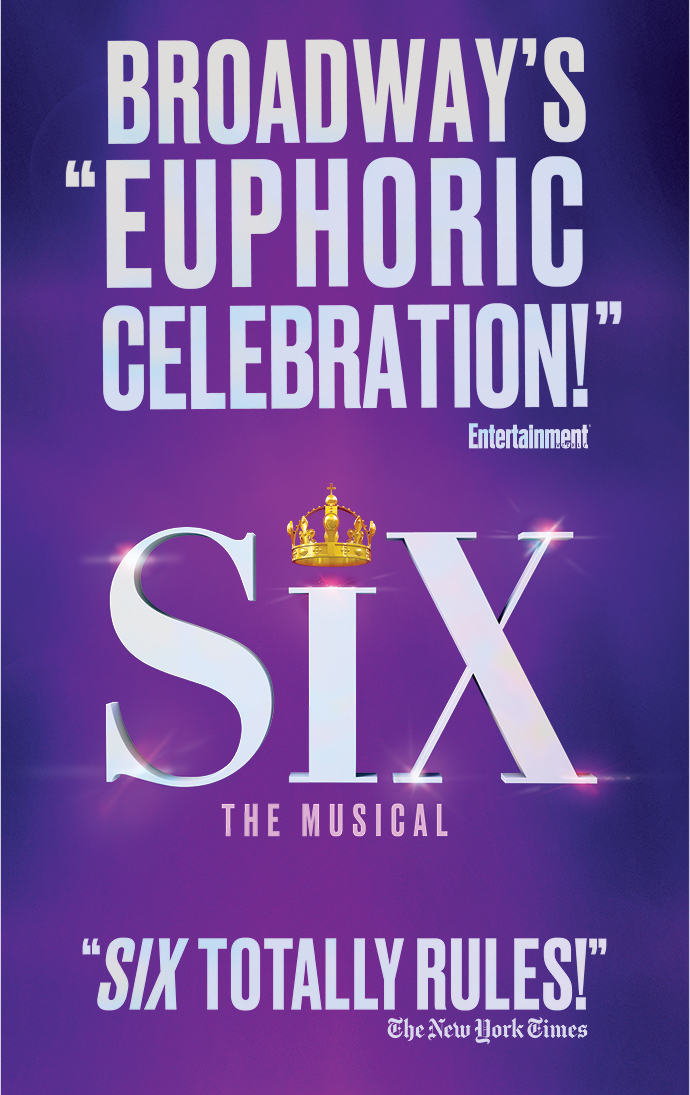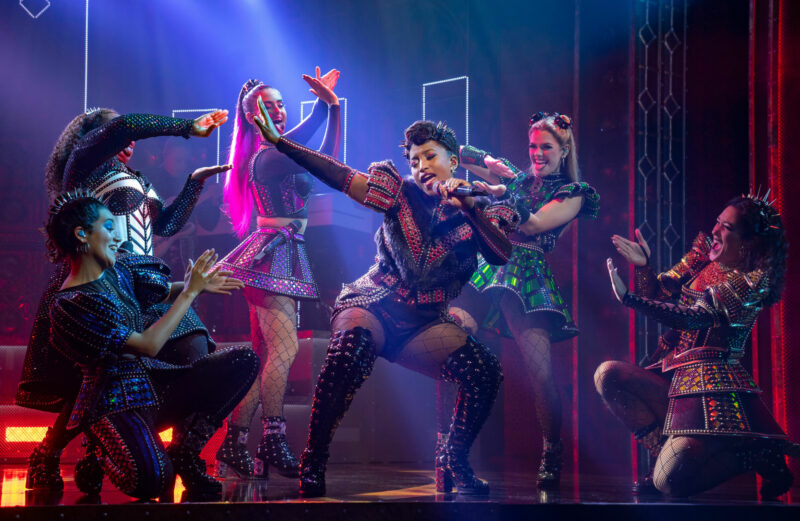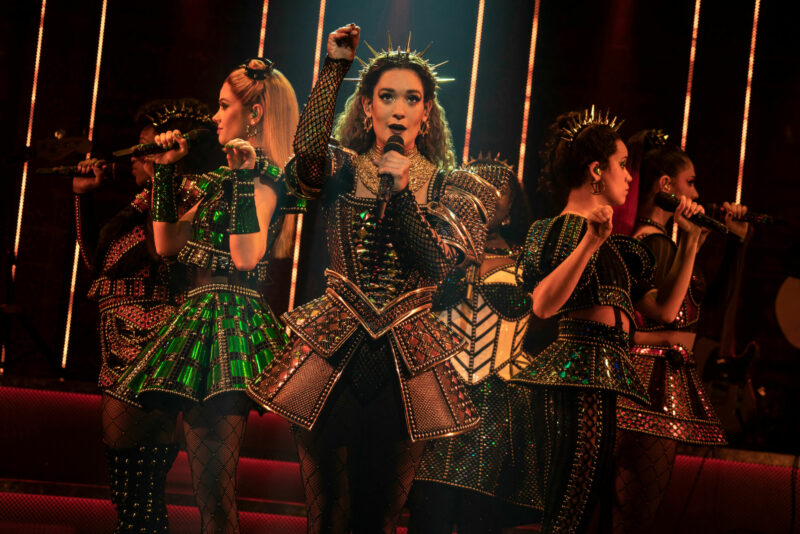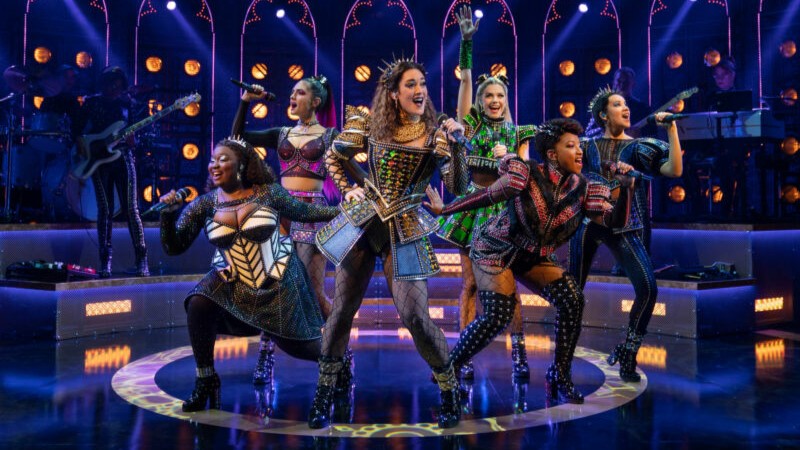SALT LAKE CITY — The hit musical Six (with music, book, and lyrics by Toby Marlow and Lucy Moss), directed by Lucy Moss (the youngest director in Broadway history) and Jamie Armitage, has taken the world by storm and has now arrived in Salt Lake City at the Eccles Theatre in Salt Lake City through January 21.

Show plays in Salt Lake City through January 21, 2024. Banner photo credit by Joan Marcus.
Six is a concert-style, 85-minute production that educates the audience about the lives of the wives of King Henry the VIII through a mix of modern day music, costume, lights, humor, and intelligence. My first experience with Six was in London the summer of 2019, where it arrived to popular acclaim. I am the target audience for a show like this. As a person who not only loves history (or herstory), I also am intrigued by the untold stories of people’s lives. Within the pop concert of Six, Catherine Parr (Henry’s sixth wife, played in a masterful fashion by Adriana Scalise) points out a pretty sad yet universal truth: the only reason we know about these women — and a lot of women throughout history — is because of the men they were tied to. Their stories only seemed to be important to tell because of the misdeeds of the historical male figure that they were entangled with. The wives’ stories have been told, and told, and told. The impressive thing about Six is the different, humorous, and haunting way that these women’s stories unfold within a short time.
After seeing Six for the first time in London, when I discovered it would be playing in Boston during the same time as a business trip for a pre-Broadway tryout, I jumped at the chance to see it again. I then had the opportunity to see it again almost exactly a week before the pandemic shut down during the production’s Broadway previews. That was when my husband said to me, “Wouldn’t it be funny if you got to see Six in six places?” Thus, a dream was born that started in London and ended on January 9th in my hometown of Salt Lake City. Having now seen Six across the sea in London, pre-Broadway, Broadway, literally on the sea (on the Norwegian Cruise Line), the first national tour in Phoenix, and the current tour here in Salt Lake, I can say that Six each time is comforting in its familiarity, fun in its differences, and increasingly educational.

Terica Marie as Anna of Cleves. Photo by Joan Marcus.
One argument I have heard from other theatregoers is that Six is not theatre, it is a concert. I vehemently disagree; the show leans heavily into theatricality via its unified technical elements, such as the lighting design by Tim Deiling, costume design by Gabriella Slade, and the amazing music and orchestrations by Tom Curran. For example, the first solo, “No Way,” starts with a great beat by percussionist Kami Lujan as the lights slowly come up on stage well timed to the beat, matching the color scheme of the costume for Catherine of Aragon (played by Gerianne Perez). The lighting then progresses within the timing of the orchestrations in a very moving way that matches the song so well. At a poignant moment when the song changes from a Beyoncé power song to a quiet ballad, the lights turn soft, white, and humble. It truly is magnificent to behold, and the lighting, music, and performances are unified in similar ways in all the songs, most notably in a haunting way in the song “All You Want to Do” sung by Kathryn Howard (played by Aline Mayagoitia). Carrie-Anne Ingrouille‘s choreography heightens this song by adding a haunting element that shows how history interpreted Kathryn’s story incorrectly.
One of the other important elements of this show is the band on stage, called the Ladies in Waiting, who wear costumes and are a prominent part in the show. I always enjoy watching the musicians in any show, and in this particular performance I was enamored by keyboardist and music director Jane Cardona, who not only looked like she was having the time of her life, but also played and conducted with such skill that I had to remind myself that there were others on stage.

Geria Pérez as Catherine of Aragon. Photo by Joan Marcus.
Each of the performers playing the queens were impressive, and all excel in the challenging five-part harmonies (something that I always enjoy in Six). In a small ensemble cast, there is no room for error, and these queens were flawless. Kelly Denice Taylor as Jane Seymour was the heroine of the night; as the alternate on the tour for Six, she need to be ready to play whatever queen is needed. Her performance was perfectly practiced and executed. She was the equal to the other women and a major asset to the evening.
As Anne Boleyn, Zan Berube used a different approach to the character that I had never seen before. I really enjoyed her blend of Avril Lavine, Britney Spears, and Kristin Chenoweth in “Don’t Lose Ur Head,” and she truly made me chuckle. Of course, Terica Marie as Anna of Cleves brought down the house with her rendition of “I’m the Queen of the Castle,” the song that is always worth the price of admission.
But it is the end of the show that brings me back to Six again and again. What Moss and Marlow have created is the perfect representation of the therapeutic practice called Restory. The six women are well known today because one man really needed a good couples’ therapist. But Moss and Marlow decided to “restory” their lives and allow the audience to see the joy of a better purpose. I long to hear all those stories and more. I love that that a play can inspire the hidden stories of these women’s lives — and inspire new generations of women to take back their voice and make better decisions. If Six prompts people to tell more hidden stories — stories that go beyond “divorced,” “beheaded,” or “died” — then it will be a profoundly meaningful play to millions. I am very excited to know what Moss and Marlow plan to do next with their young writing lives, because I will go anywhere and see anything you have written.

These reviews are made possible by a grant from the Salt Lake County Zoo, Arts, and Parks program.



